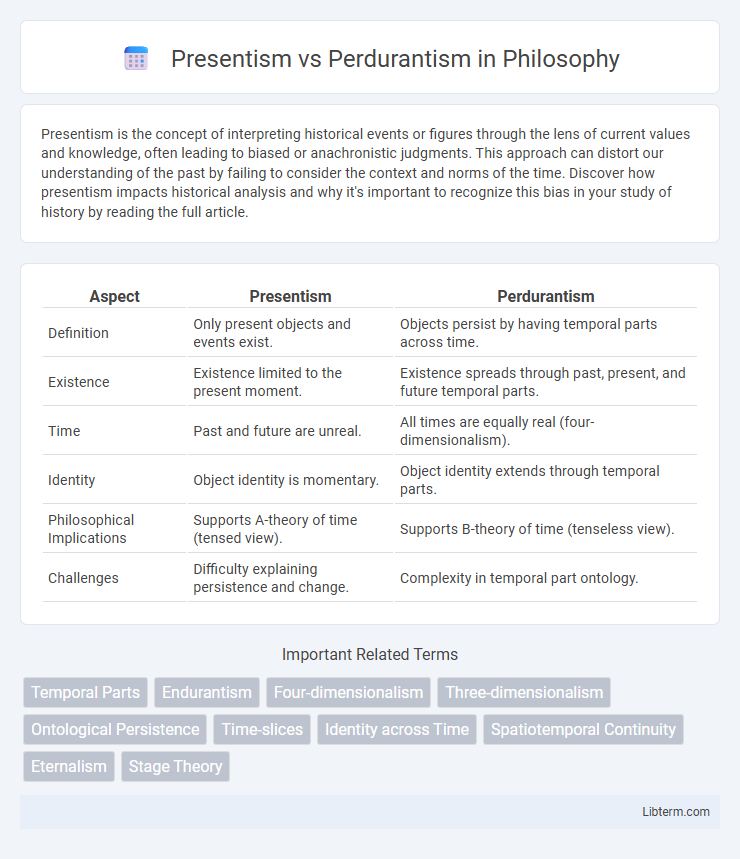Presentism is the concept of interpreting historical events or figures through the lens of current values and knowledge, often leading to biased or anachronistic judgments. This approach can distort our understanding of the past by failing to consider the context and norms of the time. Discover how presentism impacts historical analysis and why it's important to recognize this bias in your study of history by reading the full article.
Table of Comparison
| Aspect | Presentism | Perdurantism |
|---|---|---|
| Definition | Only present objects and events exist. | Objects persist by having temporal parts across time. |
| Existence | Existence limited to the present moment. | Existence spreads through past, present, and future temporal parts. |
| Time | Past and future are unreal. | All times are equally real (four-dimensionalism). |
| Identity | Object identity is momentary. | Object identity extends through temporal parts. |
| Philosophical Implications | Supports A-theory of time (tensed view). | Supports B-theory of time (tenseless view). |
| Challenges | Difficulty explaining persistence and change. | Complexity in temporal part ontology. |
Introduction to Presentism and Perdurantism
Presentism is the metaphysical theory that only present objects and events exist, denying the reality of past and future entities. Perdurantism, or four-dimensionalism, contrasts by asserting that objects persist through time by having temporal parts at different times. These opposing views address the nature of persistence and temporal existence, shaping debates in philosophy of time and metaphysics.
Defining Presentism: The Philosophy of the Now
Presentism asserts that only present objects and events exist, rejecting the reality of past and future entities. This philosophy of the now argues that temporal flow is an objective feature of reality, making the present moment uniquely real. Its ontology contrasts with Perdurantism by denying the persistence of objects through time as four-dimensional entities.
Understanding Perdurantism: Persistence Through Time
Perdurantism defines objects as four-dimensional entities extended across time, composed of temporal parts rather than being wholly present at each moment, enabling persistence through change. This view contrasts with presentism by positing that past, present, and future temporal parts all equally exist, providing a coherent explanation for how objects endure despite alteration. Philosophers employ perdurantism to address identity puzzles and frame persistence in terms of an object's complete temporal profile rather than its instantaneous state.
Historical Background and Key Philosophers
Presentism, the metaphysical view that only present objects and events exist, traces its roots to early Aristotelian philosophy, emphasizing temporal immediacy. Perdurantism, also known as four-dimensionalism, emerged primarily from the work of J.M.E. McTaggart and later analyzed by David Lewis, who argued that objects are extended in time much like they are in space. These contrasting theories illuminate debates in metaphysics regarding the ontology of time and persistence, anchored by key philosophers such as Augustine, A.N. Prior, and Ted Sider.
Ontological Commitments of Presentism
Presentism holds that only present entities exist, rejecting the existence of past and future objects, which significantly reduces ontological commitments by limiting being to current temporal slices. This view contrasts with Perdurantism, which posits that entities persist through time as four-dimensional spacetime worms, encompassing temporal parts across past, present, and future. Presentism's ontological stance simplifies existence to the immediate now, impacting how temporal existence and change are understood metaphysically.
Four-Dimensionalism Explained: The Perdurantist View
Four-dimensionalism, central to perdurantism, posits that objects extend across time as well as space, consisting of temporal parts or stages rather than existing wholly at a single moment. This view contrasts with presentism by rejecting the notion that only present objects exist, instead affirming the reality of past and future temporal parts as integral components of an object's identity. Consequently, perdurantism provides a framework for understanding persistence through change via the aggregation of these temporal segments within a four-dimensional space-time continuum.
Major Arguments Supporting Presentism
Presentism asserts that only present objects and events exist, emphasizing the immediacy of reality and aligning with common-sense temporal experience. Major arguments supporting Presentism include the intuitive appeal of the passing of time, the incoherence of future and past entities lacking causal efficacy, and the challenge Perdurantism faces in explaining the persistence of objects without appealing to temporal parts. Presentists argue that temporal distinctions reflect ontological reality, where only the present moment holds true existence, contrasting with the four-dimensional space-time view of Perdurantism.
Core Objections to Perdurantism
Core objections to perdurantism highlight problems with the ontology of temporal parts, challenging the coherence of objects existing as extended entities through time. Critics argue that perdurantism's temporal parts framework struggles to account for identity persistence without invoking problematic plurality. Furthermore, concerns arise regarding the explanative power of perdurantism in addressing change and temporal properties compared to presentism's singular, present-focused ontology.
Presentism vs Perdurantism in Modern Metaphysics
Presentism in modern metaphysics asserts that only present objects and events exist, emphasizing a dynamic ontology where past and future entities lack objective reality. Perdurantism challenges this view by proposing that objects extend through time as four-dimensional entities composed of temporal parts, allowing the coexistence of past, present, and future stages. This debate impacts theories of time, persistence, and identity, shaping contemporary discussions on the nature of temporal existence and metaphysical commitment.
Implications for Time, Reality, and Existence
Presentism asserts that only the present moment is real, implying a dynamic and constantly updating reality where past and future events do not exist. Perdurantism, or four-dimensionalism, treats objects as extended in time, composed of temporal parts, suggesting a fixed spacetime block where past, present, and future coexist equally. This fundamental difference influences metaphysical debates on the nature of existence, the passage of time, and the ontology of temporal objects, affecting theories in physics and philosophy about reality's structure and persistence.
Presentism Infographic

 libterm.com
libterm.com